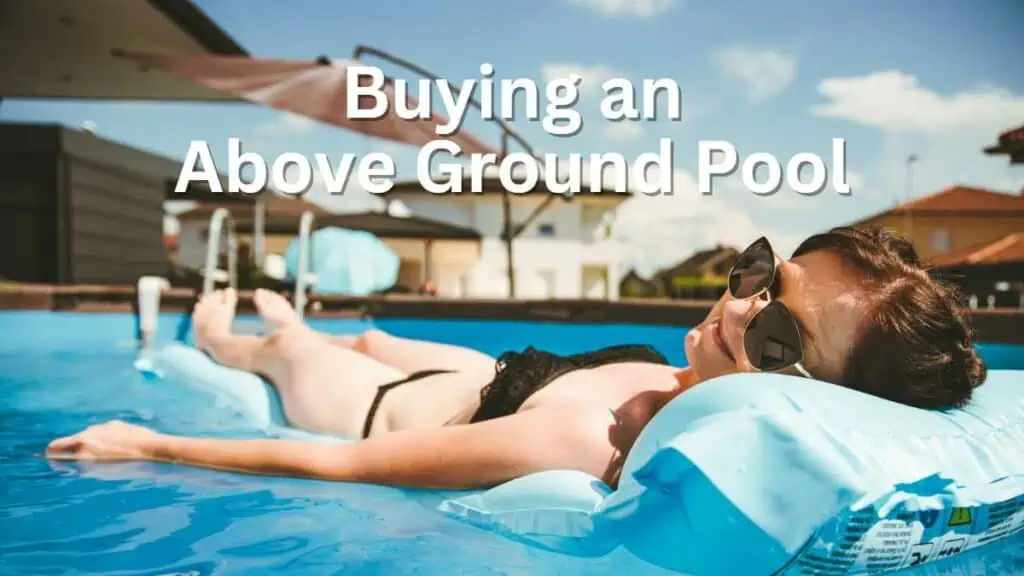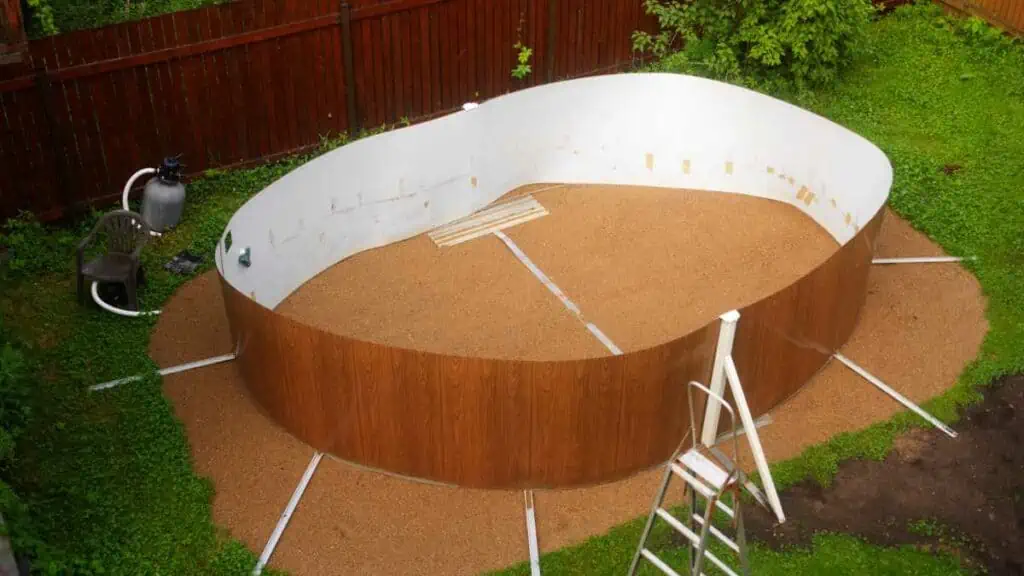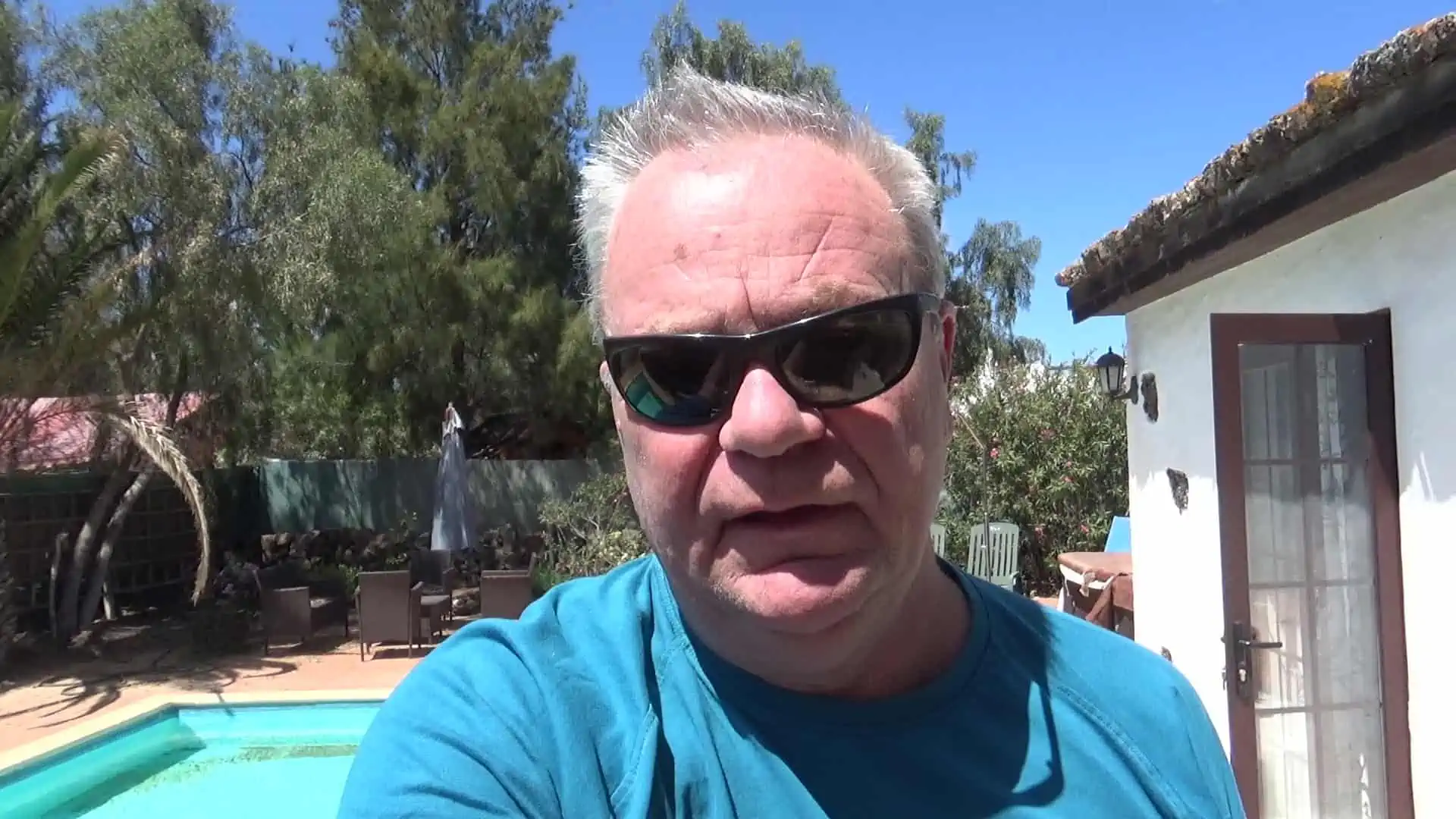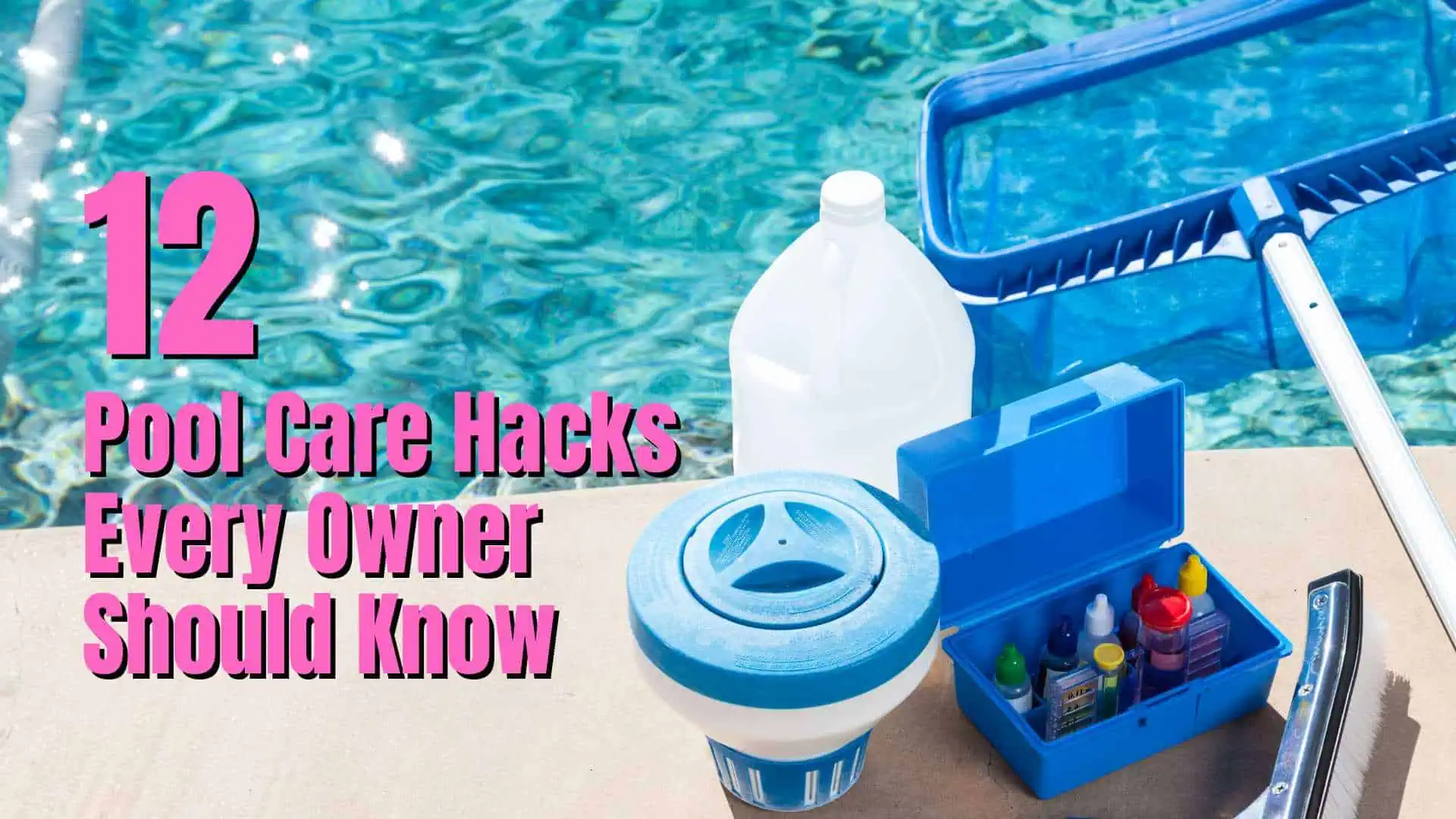Above ground pools can add an element of luxury, entertainment, and relaxation to your home, especially during those scorching summer months. These pools are also perfect for throwing parties and creating unforgettable moments with friends and family.
Above ground pools are often chosen over their inground counterparts due to their affordability and ease of installation. Nevertheless, careful planning and consideration are necessary for the successful setup of an above ground pool in your backyard.
Several crucial factors could determine the suitability of an above ground pool for your backyard. Ask yourself:
Do I have a spacious backyard?
Do I desire a large pool?
Analyze the size of your backyard in relation to the size of the pool you wish to install.

Understanding Different Types of Swimming Pools
Before we delve into the specifics of above-ground pools, let’s get an overview of the various types of pools available on the market. This will help you decide if an above ground pool is the right fit for your property.
Inflatable Swimming Pools
Inflatable pools are primarily designed for young children. They are crafted from soft and flexible material to prevent injuries and abrasions. These pools hold relatively less water, reducing the risk of drowning for small children.
Inflatable pools are cost-effective, easy to set up without professional assistance, and can often be purchased and installed for as little as $100. This makes them the most affordable pool option on the market.
Inground Swimming Pools
Inground pools are viewed as a symbol of luxury and are highly desirable. If constructed with robust materials, they can last for an extended period. Moreover, an inground pool can enhance your property value, potentially fetching a higher selling price if you choose to put your property on the market.
Installing an inground pool involves significant investment and a lengthy, costly construction process. The overall cost can start at around $35,000 and may exceed $100,000 for larger pools. However, if seen as an investment, it could yield substantial returns in the future.
Above Ground Swimming Pools
Above ground pools, also known as a backyard pool or portable pool, are a more economical alternative to inground pools. Installation is simpler since it doesn’t require deep excavation, but the structure is still permanent.
Typically, above ground pools are composed of steel and resin, a durable combination that can withstand harsh weather conditions. You have the option to hire a professional installer or undertake the installation yourself.
The installation process involves measuring, excavating a space in your yard, and assembling the pool structure. This could take up to 6 hours for someone experienced, possibly longer for a novice.
The cost of an above ground pool kit can start as low as $1,500, but the final price will depend on the size and materials of the pool. However, it’s certainly more economical than an inground pool, which could cost upwards of $35,000.
Partially and Fully Buried Above Ground Swimming Pools
Above-ground pools can vary significantly. Some models necessitate a partial or complete burial, providing an inground pool aesthetic while sidestepping the substantial cost of an actual inground pool installation.
Partially and fully buried pools tend to cost more than traditional above ground pools. On average, a semi-buried pool might cost about $10,000, more than triple the average cost of a surface-based above ground pool.
Read: Can you put an above ground pool in the ground
Preparing for Above Ground Swimming Pool Installation
The installation of an above-ground pool is a significant undertaking. Proper planning before purchasing any items can prevent missteps and incorrect purchases. Here’s what you need to prepare:
Select a Location for the Pool
Decide on a suitable spot in your backyard for the installation of your above ground pool. This spot should be away from neighbors and comply with local regulations. Given the elevated vantage point of above ground pools, privacy considerations are key.
Determine an Appropriate Pool Size
Ensure the size of your selected pool is compatible with the intended installation spot. It’s crucial to understand that even slight changes in diameter can significantly affect the pool’s water and human capacity.
Consider the number of people you anticipate will use the pool simultaneously. If you plan on hosting pool parties, you’ll require a larger pool, necessitating a more spacious location in your backyard.
Keep in mind that a larger pool will incur higher costs. Unless you host regular pool parties, a larger pool may not be a sound investment. A standard pool that can accommodate 3 to 4 people is often sufficient.
Selecting the Right Materials
Securing the pool requires the right mix of materials. The base pad beneath the pool should be durable. A foundation of mason sand covered by stones around the edge can provide stability.
A construction or landscaping company can deliver these materials to your home, eliminating the need for personal transportation. Home improvement or pool stores that supply these materials typically arrange delivery.
How much does an above ground pool cost?
Keeping track of all installation and maintenance costs is crucial. The first significant expense will be the pool kit, followed by the cost of installation.
Average above ground pool kits range from $1,500 to $8,000, while installation costs vary between $1,000 and $3,000, both heavily influenced by pool size and materials. Total costs for your above ground pool will likely fall between $2,500 and $11,000+.
Don’t overlook the costs of utilities, accessories, and a deck. These items aren’t included in the pool kit and must be purchased and installed separately.
The following items and services may add to your total expense:
Deck: $2,500 or higher Water: $80 to $1,200 (to fill the pool) Electricity: $350 to $500 Water Pump and Pool Filter: $750 to $1,100 Pool Cover: $20 to $450 Pool Chemicals & Sanitation: $50 to $100 monthly
The above estimates will give you a rough idea of what to budget for your above ground pool installation.
Installation Procedure

With your financial plan established, it’s time to embark on the installation process for your above ground pool. Here are the primary stages:
- Preparation and Marking of the Pool Site
You should already have picked out the ideal spot in your backyard for your pool. Now it’s time to prepare this space by removing any grass, rocks, and other obstructions, and then marking the boundaries with stakes and ropes. Remember to verify local barrier codes with your area’s zoning and building authorities.
- Leveling of the Pool Site
Since the chosen site is unlikely to be uniformly flat, leveling is crucial. A professional landscaper would be well-equipped to perform this task swiftly and efficiently, possibly utilizing tools like a skid steer or bobcat.
- Drainage Planning
Expect a considerable amount of water to end up on the ground around the pool due to splashing. To prevent this area from turning into a marshy mess, you’ll need to plan and install appropriate drainage systems.
- Foundation Construction
The pool foundation consists of patio stones and blocks positioned around the pool area. Ensure these blocks are leveled to guarantee a stable pool frame.
- Installation of Pool Base Material
The pool base pad is the layer that separates the ground from the liner’s delicate vinyl membrane. It’s designed to handle debris like insects, small animals, rocks, and stones. A robust pool base also contributes to the overall stability of your pool.
- Liner Placement
With the pool base pad in place, the liner can now be laid over it. Aim to position the liner with as few wrinkles as possible; small wrinkles aren’t a big deal, but larger wrinkles and folds can cause problems. It’s crucial to address any significant wrinkles before adding water.
- Frame Assembly
The pool frame can now be assembled on site. Follow the manufacturer’s instructions to the letter. Pay close attention to the shape being formed, ensuring it matches the intended design. Also, confirm that all bolts and screws are fully tightened.
- Debris Clearance
Post-installation, there’ll be a lot of leftover sod and dirt. Consider redistributing this to other parts of your yard instead of discarding it. Keep any leftover packaging materials in a safe place like your garage or shed. They could come in handy if you ever need to disassemble your pool.
- Compliance with Local Codes
Some jurisdictions require pool owners to display a pool permit during construction. Additionally, if your pool involves electrical wiring, you’ll need to ensure the setup complies with local electrical codes.

Maintenance Tips for Above Ground Swimming Pools
Maintaining your pool need not be a complicated process. Regular and organized maintenance can keep the water in good condition. This is what you will have to do:
Run the Pool Filter Daily
Choose a pool filter that efficiently removes bacteria and debris from the water. It should run for a minimum of 12 hours per day, or ideally, around the clock.
Perform Weekly pH Tests
The pH of your pool water should be tested weekly. The ideal level is between 7.2 and 7.6. If it falls outside of this range, use the necessary chemicals to correct it.
Conduct Regular Chlorine Tests
For pools using chlorine, maintain a level of around 2.0 to 4.0 ppm. Inadequate chlorine levels will result in green, unsightly water.
Clean the Pumps and Skimmers of Debris
The pump and skimmer baskets can fill with debris, hindering the filter’s operation. Regularly clear out these baskets to keep your filtration system working optimally.
Inspect for Algae and Mold
Even with chlorine, you might find algae buildup in certain parts of the pool. Be sure to remove these deposits and clean the affected areas promptly.
Must-Have Accessories for Above Ground Pools
Essential accessories for an above ground pool include:
- Pump: Necessary for water circulation, cost ranges from $300 to $500.
- Filters: Work with the pump to clean the pool water, priced between $450 and $750.
- Perma Salt (optional): A natural alternative to chlorine for those who prefer fewer chemicals in their pool water.
- Steps: To aid pool entry, typically costing between $250 and $450.
- Ladder: For easy exit from the pool, usually priced between $150 and $250.
- Storage Units: Handy for storing pool accessories, ranging from $250 to $500.
- Fencing: Essential for safety, especially around children, costs range from $150 to $350.
- Cleaning equipment: Net, vacuum hose, vacuum head, pool brush
- Robotic Pool Cleaners: Make pool maintenance a breeze, prices range from $230 to $1200.
Also Read: Best Above Ground Pool Pump and Filter: Top Picks for 2023
Four Tips To Remember
Here are four key tips to keep in mind before venturing into the purchase of an above ground pool:
Establish Your Budget
Before making any purchases, it’s crucial to have a clear understanding of your budget. This will help you avoid any unexpected costs or ongoing expenses. Do your research thoroughly.
Engage a Certified Pool Installer
If you’re considering professional assistance for the installation, make sure the pool builder you hire has the requisite qualifications and a positive track record. Review their professional history and customer service reputation to ensure they’re reliable.
Seek a Maximum of Four Quotations
While securing a good deal is important, you don’t want to inundate yourself with numerous estimates. Aim to collect between 3 and 4 quotations, then decide which best suits your budget and pool requirements.
Visit a Brick-and-Mortar Store
An above ground pool is a significant purchase, hence it’s advisable to avoid making this purchase online or over the phone. Instead, visit a local pool store to physically inspect the options available. This will provide a better understanding of the pool’s size and material quality, leaving no room for misconceptions.
Choosing the Best Above Ground Pool
Your choice is largely dependent on the available space in your backyard. If you have ample space, you might opt for a pool complete with deck and rails. A smaller space, however, might only accommodate a pool surrounded by a stone wall.
Your pool’s primary use is another factor. If you envision hosting large parties or gatherings, a larger pool with an expansive deck could be suitable. If not, a smaller pool might be a more cost-effective option.
Ensure your pool doesn’t overwhelm your backyard. Retain enough free space for other activities, including playing with your family pet.

I have had hot tubs for over 20 years and a pool for the last 10 years. I had to learn how to clean, maintain and fix them the hard way. Since then I have helped many friends and neighbors with their pools and now I want to share everything I have learned with you. About Me



